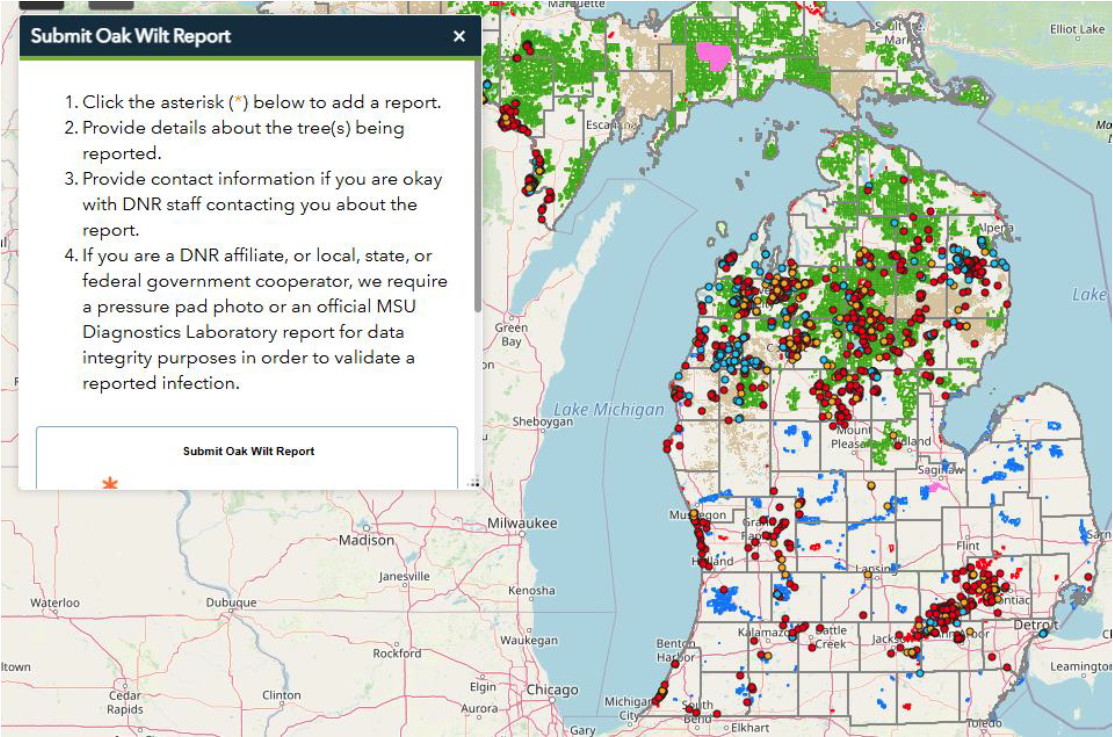The spring growing season brings new opportunities to prevent oak wilt
Staying informed about oak wilt helps homeowners make good decisions that save oak tree lives.

Thousands of oak trees succumb to the deadly oak wilt disease on an annual basis in Michigan. While complete eradication of the disease may be unrealistic, slowing the spread and reducing oak deaths is definitely possible.
Controlling oak wilt starts with landowners. Knowing the disease cycle helps guide better pruning decisions. The oak wilt disease cycle begins with Nitidulidae beetles that carry fungal spores and are attracted to fresh pruning cuts. When these beetles land on an open wound, they deposit spores, leading to infection. Soon, the oak shows symptoms such as wilting leaves. This overland transmission is depicted at the top of the disease cycle graphic (Photo 1).
At the bottom of the disease cycle, a recently killed tree produces spore mats, initiating a second transmission mode: underground spread. Oak trees connect underground via root grafts, or places where their roots grow together. The root grafts allow the trees to share water and nutrients but also create a path for oak wilt to spread from one tree to the next. When oak wilt spreads through the roots, it creates a pattern of dying trees radiating outward. If left unmanaged, the disease spreads in an expanding circle.
How to stop oak wilt
To prevent oak wilt, follow these key steps:
- Prune safely. Prune oaks in winter when trees are dormant and beetles are inactive. If a tree is wounded during the high-risk period (April 15–July 15), immediately seal the wound with pruning seal or latex paint to keep beetles out.
- Act quickly. If trees show oak wilt symptoms, take action to contain the disease and minimize tree loss.
Diagnosing and managing oak wilt
Early diagnosis is crucial. Testing for oak wilt is now easier—simply send 15-20 fallen symptomatic (those showing discoloration and/or bronzing) leaves to the Michigan State University Plant and Pest Diagnostics lab for analysis.
Learn more about how to properly collect a leaf sample for oak wilt testing. A good rule of thumb is to include a second sample from either a branch or living tissue from the trunk of an infected tree. Both sampling techniques are described in the article “The best sampling procedures for accurate oak wilt testing” by Michigan State University Extension.
If oak wilt is confirmed, consult a trained arborist. Proper management protocols must be followed to stop the disease from spreading. Find an oak wilt qualified specialist through the Michigan Oak Wilt Coalition.
Michigan Department of Natural Resources Oak Wilt Viewer
To learn more about the risk of oak wilt in your neighborhood, consult the Michigan Department of Natural Resources’ Oak Wilt Interactive Mapping Tool (Photo 2). Through this tool, landowners and professionals can self-report suspect oak wilt infections. The location of each reported infection is shown as a dot in one of three colors to indicate if the infection is confirmed positive, treated or just reported with no follow up confirmation. This tool allows landowners to assess the distance to the nearest reported oak wilt infection, which can be helpful in making oak wilt management decisions.
Please note that the interactive map is not a comprehensive look at oak wilt in the state; it relies on landowner reports. If you know of a confirmed oak wilt location, please add it to the map.

By understanding oak wilt and taking preventive measures, homeowners can help protect Michigan’s oak trees for future generations.



 Print
Print Email
Email